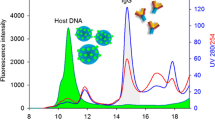Abstract
To determine the influence of various culture conditions, transformed cells of Escherichia coli expressing recombinant green fluorescent protein (GFPuv) were grown in nine cultures with four variable conditions (storage of inoculated broth at 4°C prior to incubation, agitation speed, isopropyl-β-d-thiogalactopyranoside [IPTG] concentration, and induction time). The pelleted cells were resuspended in extraction buffer and subjected to the three-phase partitioning (TPP) extraction method. To determine the most appropriate purification resin, protein extracts were eluted through one of four types of HiTrap hydrophobic interaction chromatography (HIC) columns prepacked with methyl, butyl, octyl, or phenyl resins and analyzed further on a 12% sodium dodecylsulfatepolyacrylamidegel. With Coomassie staining, a single band between 27 (standard GFPuv) and 29 kDa (molecular weight standard) was visualized for every HIC column sample. TPP extraction with HIC elution provided about 90% of the GFPuv recovered and eight-fold GFPuv enrichment related to the specific mass. Rotary speed and IPTG concentration showed, respectively, greater negative and positive influences on GFPuv expression at the beginning of the logarithmic phase for the set culture conditions (37°C, 24-h incubation).
Similar content being viewed by others
References
Chalfie, M. and Kain, S. (1998), in Green Fluorescent Protein Properties: Applications and Protocols. Chalfie, M. and Kain, S., eds., Wiley-Liss, New York, NY, pp. 3–75.
Wheelwright, S. M. (1991), Protein Purification, Design and Scale Up of Downstream Processing. Wheelwright, S. M., ed., John Wiley & Sons, New York, NY, pp. 154–162.
Sambrook, J., Fritsch, E. F., and Maniatis, T. (1989), in Molecular Cloning: A Laboratory Manual. 2nd Ed., Nolan, C., ed., Cold Spring Harbor Laboratory, Cold Spring Harbor, New York, pp. 1.74–1.84.
Vessoni Penna, T. C., Chiarini, E., Machoshvili, I. A., Ishii, M., and Pessoa Jr., A. (2002). Appl. Biochem. Biotechnol. 98–100, 791–802.
Denninson, C., and Lovrien, R. (1997), Protein Expr. Purif. 11, 149–161.
Sharma, A. and Gupta, M. N. (2001), Process Biochem. 37, 193–196.
Vessoni Penna, T. C., Chiarini, E., and Pessoa Jr., A. (2003), Appl. Biochem Biotechnol. 105–108, 481–491.
Drapper, N. and Smith, H. (1981), Applied Regression Analysis John Wiley, New York, NY.
Scopes, R. K. (1993), in Protein Purification: Principles and Practice. 3rd Ed., Cantor, C. R., ed., Springer-Verlag, New York, NY, pp. 39–89, 324–325.
Shi, H. and Su, W. W. (2001), Enzyme Microb. Technol. 28, 25–34.
Yakhnin, A. A., Vinokurov, L. M., Surin, A. K., and Alalhov, Y. B. (1998), Protein Expr. Purif. 14, 382–386.
Author information
Authors and Affiliations
Corresponding author
Rights and permissions
About this article
Cite this article
Penna, T.C.V., Ishii, M., Junior, A.P. et al. Evaluation of recombinant green fluorescent protein, under various culture conditions and purification with HiTrap hydrophobic interaction chromatography resins. Appl Biochem Biotechnol 114, 453–468 (2004). https://doi.org/10.1385/ABAB:114:1-3:453
Issue Date:
DOI: https://doi.org/10.1385/ABAB:114:1-3:453




